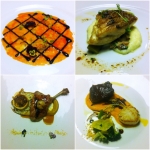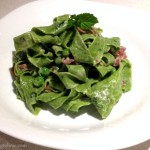Let me begin by stating a couple of facts;
1. I have had a lifelong love affair with Alpaca’s since I saw one called Charlie on Totally Wild when I was about 12 years old.
2. Alpaca’s always poo in one spot… No crap.
3. Alpaca’s are seriously gorgeous.
Ok, now we’ve got those entertaining, factual points out of the way, let me state a few more;
4. Alpaca’s have been farmed for thousands of years in South America for not only their soft, soft wool but for their sweet and mild meat. Loooong before their bovine besties ever made their delicious debut.
5. Alpaca meat is super-dooper healthy. Compared to the other ‘mainstream’ meats like beef, lamb and pork, it’s by far the leanest. High in protein, high in iron and low in fat.
6. Alpaca’s are seriously tasty.
Now, before you get all P.E.T.A. on me, let me tell you a little story…
Note to Everyone: Unless you are a Vegetarian (and not a quasi-vego who still wears leather), your animal rights arguments against eating Alpaca, are quite literally, meat headed.
Once upon a time, in 1990, a young woman named Adrienne Williams was at the Royal Adelaide Show.
It was there, across a crowded room, that she first locked stares with destiny.
It was love at first sight.
A tall and mysterious, curly haired, foreign stranger, with a big toothy smile and kind eyes.
It was there that she met, her first Alpaca.
After this chance encounter, Adrienne and her new husband Chris, decided to trust in fate and took a blind leap of faith. They embarked on an epic journey together, and history began…
Fast forward to 2015. Adrienne and Chris have built an Alpaca farm with one of our nations largest coloured herds, an unparalleled number of champions and some of the most highly awarded and finest Alpaca’s in Australia.
They treat their little furry children with love, care and respect.
They bottle feed the sick and orphaned babies.
The animals roam freely in large pastures.
They live a good life, without harm and fear.
They trust humans, because they have no reason not to.
But alas, this is the world of farming, and the best intentions are not always enough…
For you see, sometimes the Alpaca’s don’t make the grade. Sometimes, their purpose of providing soft, luxurious pelts for wool or being top-notch breeding stock, just cannot be met. Sometimes, they cannot be sold due to teeth problems and ailments. Sometimes, they are born and their fate, sadly, is already sealed.
No working farm could sustain itself, should it hold onto every animal that cannot produce. There’s no aged care facilities and buses to the community centre for elderly livestock. There’s no Unicorns and Fairies, in a farmyard fantasy land. This is reality, like it or not.
But Chris and Adrienne, they love their Alpaca’s. They won’t send them off without a fight.
Firstly, they sell these guys as pets. Up until the age of 12 months, they can be hand reared.
And, after that until they are 2, they are sold to guard sheep.
But then, if all hope is lost for a reprieve, they are carefully escorted in small groups to a local abattoir, where they meet a respectful, and stress free end.
Can’t say the same for bobby calves…
And battery hens…
Or factory pigs…
Or many other industrially farmed animals…
So why the stigma about a grass-fed, cared for and loved, 2 year old Alpaca?
The Williams’ respect their Alpaca’s, and they don’t want to waste their precious bodies, as so many other farms do.
They are on a mission to introduce this seemingly taboo meat to South Australia and beyond.
They hope, that their love for this remarkable product will be shared, and now, so do I.
Alpaca tastes like veal. It isn’t gamey in any way.
My children LOVE it, and it’s healthy… I know, Right?!!
The Mogwai had 3 bowls of my Alpaca Ragu in one sitting. Not too shabby for a three year old.
In fact, everyone I’ve served Alpaca to, thinks it’s finger lickin’ good.
OK, I’m not gonna lie, the first time I was told about Alpaca meat I cringed a little. Visions of my fantasy, ginger haired Alpaca Kerry, circling through my mind…
But, then I considered it.
And then, I met the Williams family and visited their farm, listened to their story and met their gorgeous herd.
And then, I tasted it, and I was sold.
I look forward to creating recipes with this beautiful meat, for years to come.
And, I promise if you open your mind and give it a go, you will too.
So I say, to all my fellow Jedi foodies and health conscious, meat lovin’ Storm Troopers…
Go forth and may the force be with you.
Don’t be a Drone, be a Han Solo YOLO and Chew-Pacca.
Until Next week xxx
For more detailed information (including nutritional information and stockists), please go to the following site;
http://www.fleurieuprime.com.au/
- 1kgs Alpaca Neck Rosettes
- 1 large Brown Onion
- 1 large Carrot
- 3 Celery Sticks
- 2 Cloves of Garlic
- Olive Oil
- Salt and Pepper
- ½ cup of White Wine
- 1 cup of Chicken Stock – plus extra
- 410gm tin of Tomato Puree or Passata
- 2 whole stalks of fresh Rosemary
- Semolina Gnocchi
- 2 cups of Chicken Stock
- 2 cups of Whole Milk
- 1 stalk of Rosemary
- 1 whole sprig of fresh Sage
- 300gms of coarse Semolina
- 100gms of freshly grated Parmesan
- 100gms of Butter
- ½ cup of cream plus ¼ cup of cream extra
- Salt and Pepper
- Oil and butter for greasing
- Heat your pressure cooker or heavy based casserole over a medium-high heat. Toss the rosettes in 2 tbs oil, season well and sear in batches until they are well browned on both sides. Remove from the pan and set aaside.
- In the Same pan, fry the finely diced onion, carrot, celery (including celery leaves if there are any) and chopped garlic. Cook stirring well for another 5 minutes until the vegetables are starting to break down. Now add the wine and cook for a further minute before adding the stock, tomato puree and rosemary. Stir well, and then carefully place the rosettes into the pan, ensuring they are completely submerged in the liquid.
- If you are using a pressure cooker, place the lid on and bring to high pressure, then cook for 2 hours. If you are using a conventional oven, preheat your fan-forced oven to 160°c. Wet a piece of baking paper and slightly scrunch it up, lay this paper over the surface of the Ragu, then triple wrap the pot with foil, this will ensure the steam and flavour does not escape and the Ragu doesn’t dry out during the long cooking process. Place the lid on your casserole over the foil, and bake for 6 hours. Check every 2 hours and add more stock if necessary.
- Once the Ragu is cooked, carefully remove all the bones and rosemary stalks, and then shred the meat with a fork. Season well and Serve the Ragu with the Semolina Gnocchi.
- To make the Gnocchi - In a large saucepan, heat together the stock, milk, rosemary and sage. Bring to the boil, and then remove the herbs.
- In a steady stream, whisk in the semolina, then reduce the heat and stir for 3 minutes until smooth and cooked.
- Quickly stir in half the parmesan, the butter and ½ cup of cream. Season well.
- Oil a large 20cm x 30cm lamington tray (or similar), then working quickly, evenly spread the hot semolina into the tray to about 2cm thickness. Leave to cool for at least 1 hour, before turning the set semolina out onto a board.
- Cut circles out of the semolina using a 6cm round cutter.
- Grease a 20cm x 20cm oven dish with butter and lay the semolina offcuts on the bottom of the dish. Then arrange the circles, by overlapping them, over the offcuts.
- Sprinkle over the remaining parmesan and the ¼ cup of cream, then bake in a fan-forced 180°c oven for 30 minutes until golden brown.







PK says
Chew-pacca!! Ha, love it…
Sounds yummy Bree - will give it a whirl! x pk
Please do PK! Let me know what you think X